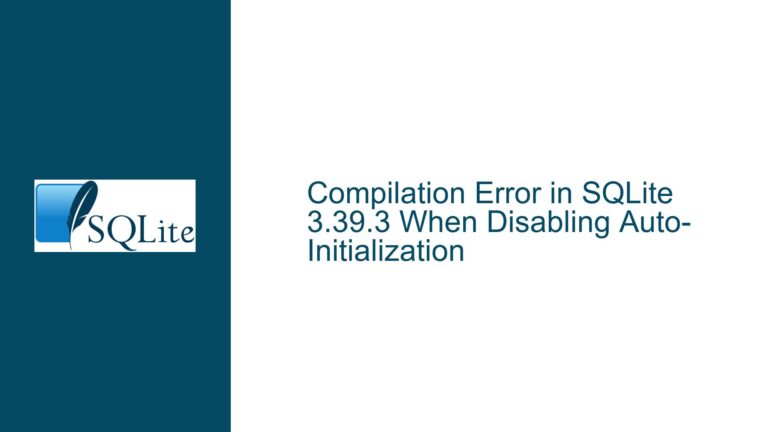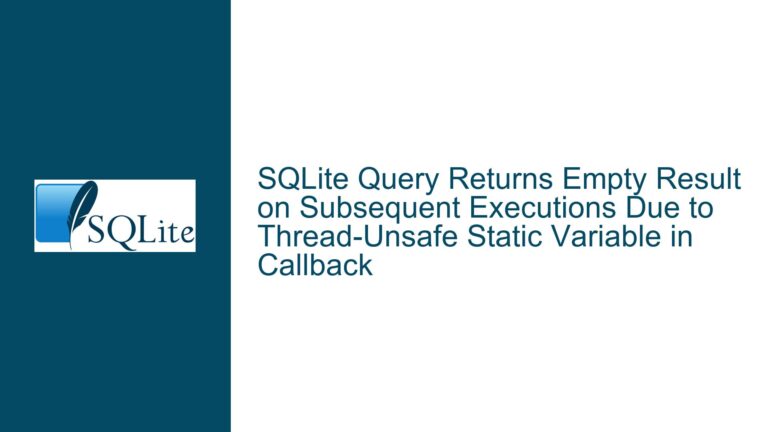Return Output from Queries in Console
Understanding the Need for Output in SQLite Queries
In the realm of database management, particularly when working with SQLite, users often seek immediate feedback from their executed queries. The discussion initiated by Amy highlights a common frustration: the lack of output from basic SQL operations, specifically during CREATE and DELETE commands. This absence of feedback can lead to confusion and uncertainty about whether the intended operations were successful.
The Importance of Query Feedback
When executing SQL commands, especially in a command-line interface (CLI) environment, users typically expect some form of confirmation or output indicating the success or failure of their queries. This expectation is rooted in user experience design principles that prioritize clarity and feedback. For instance, when a user creates a table, they might anticipate a message such as "Table created successfully." Similarly, after deleting records, a confirmation like "X rows deleted" provides reassurance that the operation was executed as intended.
In SQLite, however, not all commands return output by default. The CREATE command does not provide any confirmation upon successful execution, which can leave users uncertain about whether their table has been created. This is particularly problematic for those who are new to SQL or SQLite, as they may not be aware that the absence of an error message typically indicates success.
The Role of the RETURNING Clause
The discussion also touches upon the RETURNING clause, which can be used with DELETE statements to return information about the deleted rows. This feature allows users to see which records were removed from the database, thereby providing valuable feedback. For example, executing a command like:
DELETE FROM test WHERE key = 2 RETURNING *;
will return the details of the row that was deleted, assuming there was indeed a match. This capability is particularly useful when working within transactions, as it allows users to confirm actions before committing changes to the database.
User Expectations vs. SQLite Behavior
The disparity between user expectations and SQLite’s behavior can lead to misunderstandings about how queries operate within this lightweight database system. Many users come from backgrounds using other database management systems (DBMS) that provide more verbose feedback on query execution. For example, Oracle’s command processor confirms actions with messages like "table created" or "n rows deleted," setting a precedent for what users expect when transitioning to SQLite.
Moreover, users may be unaware that they can use additional SELECT statements to generate custom messages after executing their queries. For instance:
CREATE TABLE test(key INTEGER, value TEXT);
SELECT 'Table creation successful' AS Message;
This approach allows users to create their own feedback mechanisms within their scripts or interactive sessions.
Summary of User Concerns
Amy’s inquiry reflects a broader concern among SQLite users regarding how to effectively manage and visualize query outputs. While some responses in the forum suggest workarounds—such as employing custom messages or leveraging the RETURNING clause—these solutions may not address the fundamental issue of user expectations for immediate feedback.
Understanding these nuances is crucial for both new and experienced users alike. By recognizing how SQLite handles query outputs differently than other systems and employing strategies to provide feedback through custom messages or specific clauses like RETURNING, users can enhance their interaction with this powerful yet minimalist database engine.
In conclusion, addressing the need for output in SQLite queries involves understanding both user expectations and the inherent design choices of SQLite itself. By leveraging available features and adapting query practices accordingly, users can achieve a more satisfying and informative experience when working with their databases.
Task Management Database Design
To effectively manage tasks within a database, it’s crucial to establish a well-structured schema that accommodates task prioritization, status tracking, and relationships among various entities. Below is a detailed overview of the essential components for designing a task management system.
Key Tables and Their Structures
Task Table
- This table holds the basic details of each task.
- Columns:
taskID(Primary Key)taskName(String)priority(Integer or Float for flexible ordering)statusID(Foreign Key referencing Status Table)createdDate(DateTime)dueDate(DateTime)
Status Table
- This table defines the possible statuses a task can have.
- Columns:
statusID(Primary Key)statusName(String) — e.g., Not Started, In Progress, Blocked, Completed
Project Table
- This table contains information about different projects under which tasks are categorized.
- Columns:
projectID(Primary Key)projectName(String)startDate(DateTime)endDate(DateTime)
Task_Project Relationship Table
- To manage the many-to-many relationship between tasks and projects.
- Columns:
taskID(Foreign Key referencing Task Table)projectID(Foreign Key referencing Project Table)
Example Schema Representation
| Table Name | Columns |
|---|---|
| Task | taskID, taskName, priority, statusID, createdDate, dueDate |
| Status | statusID, statusName |
| Project | projectID, projectName, startDate, endDate |
| Task_Project | taskID, projectID |
Task Prioritization Strategy
To handle dynamic prioritization without extensive reordering:
Utilize a floating-point number for the priority column. This allows for inserting new priorities between existing ones without needing to update all tasks.
For example:
- Initial priorities:
1. Task A 2. Task B 3. Task C - If Task B becomes more important than Task A:
1. Task A (1.5) 2. Task B (1) 3. Task C
- Initial priorities:
This approach minimizes the need for frequent updates across multiple records.
Status Tracking Implementation
Each task can have multiple status updates over time. To track this efficiently:
- Create a separate Status History Table:
| Column Name | Description |
|---|---|
| statusHistoryID | Unique identifier for each status update |
| taskID | Foreign key referencing the Task Table |
| statusID | Foreign key referencing the Status Table |
| timestamp | DateTime indicating when the status was updated |
Conclusion
This database design provides a robust framework for managing tasks effectively while allowing for flexibility in prioritization and status tracking. The use of foreign keys ensures data integrity and supports complex relationships among entities without redundancy. By implementing these structures, organizations can enhance their task management processes significantly.
Task Management System Design Considerations
Designing a task management system requires careful attention to several critical aspects to ensure functionality, scalability, and data integrity. Below are the essential considerations for creating an effective database schema for a task management application.
Database Structure and Relationships
The database should be organized into distinct tables that represent the core entities involved in task management. The primary entities typically include Users, Tasks, Projects, and Statuses.
| Table Name | Description |
|---|---|
| Users | Stores user information such as user ID, name, email, and role. |
| Tasks | Contains details about each task, including task ID, name, description, priority, due date, and status. |
| Projects | Holds project information that tasks may be associated with, including project ID and name. |
| Statuses | Defines the various statuses a task can have (e.g., Not Started, In Progress, Completed). |
Entity-Relationship Diagram (ERD)
An ERD is beneficial for visualizing the relationships between these entities. For instance:
- Users can be assigned multiple Tasks.
- Each Task can belong to one Project.
- Each Task has one Status, but a Status can apply to multiple Tasks.
Normalization Principles
Normalization is essential to reduce data redundancy and improve data integrity. The database should adhere to at least the Third Normal Form (3NF), ensuring that:
- Each table has a primary key.
- All non-key attributes are fully functionally dependent on the primary key.
- There are no transitive dependencies.
Scalability Considerations
As the volume of tasks and users grows, the database should be designed to scale efficiently. This includes:
- Implementing indexing on frequently queried columns (e.g., task names, due dates) to enhance performance.
- Using partitioning strategies for large tables if necessary.
Data Integrity and Security
To maintain data integrity:
- Use foreign keys to enforce relationships between tables.
- Implement constraints to ensure valid data entries (e.g., non-null values for critical fields).
For security:
- Define user roles and permissions to control access to sensitive data.
- Consider encrypting sensitive information stored in the database.
Testing and Maintenance
Thorough testing is crucial before deployment. This includes:
- Unit testing each component of the database schema.
- Load testing to verify performance under expected user loads.
Post-deployment, regular maintenance should include monitoring performance metrics and making adjustments as necessary based on usage patterns.
Conclusion
A well-designed task management system database is fundamental for efficient operations. By following best practices in database design—such as establishing clear relationships among entities, adhering to normalization principles, ensuring scalability, and maintaining data integrity—organizations can create a robust framework that supports their task management needs effectively.






